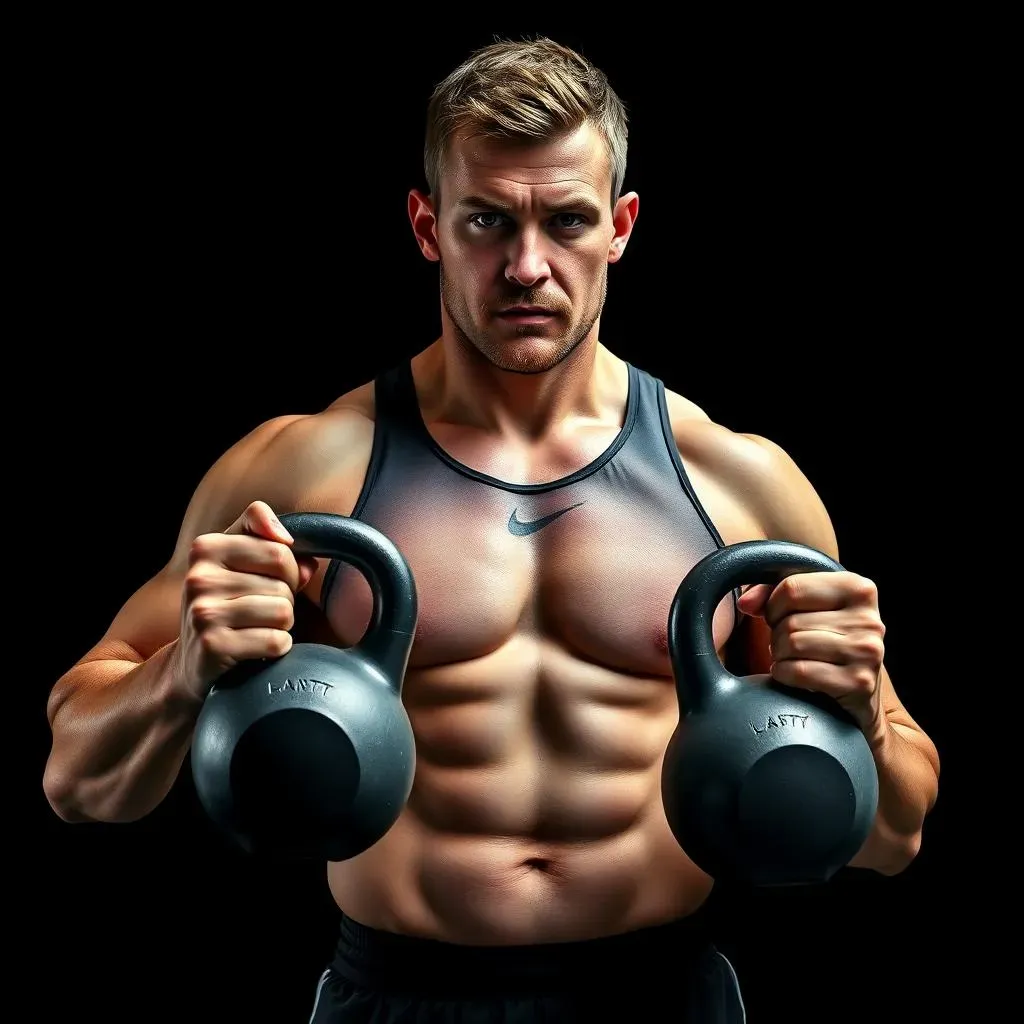Table of Contents
Are you tired of the same old bicep curls and looking for a way to spice up your arm day? Forget those boring dumbbells, because we're diving into the world of kettlebell workouts biceps! You might think kettlebells are just for swings and squats, but trust me, they're a fantastic tool for building impressive biceps. This article isn't just another list of exercises; we'll explore why kettlebells are so effective for bicep growth, highlight the best moves to target those muscles, and show you how to create a killer routine. I'll also point out some common pitfalls that can slow down your progress so you can avoid them. Whether you're a seasoned lifter or just starting your fitness journey, get ready to unlock the power of kettlebells and take your bicep game to the next level. Let's get started and turn those arms into cannons!
Why Kettlebell Bicep Workouts Are Effective

Why Kettlebell Bicep Workouts Are Effective
Unique Muscle Activation
so you're thinking about kettlebells for biceps, right? It's not as crazy as it sounds. Unlike dumbbells where the weight is evenly distributed, kettlebells have an offset center of gravity. This means your muscles, especially your biceps, have to work harder to stabilize the weight throughout the movement. That constant tension? It's like a free ticket to gainsville. You're not just lifting weight, you're fighting to control it, which leads to more muscle fibers being activated.
Think about it like this: Imagine trying to balance a water balloon versus a bowling ball. The water balloon is always shifting, right? That's your bicep working overtime with a kettlebell.
Grip Strength and Forearm Engagement
Here's a little secret: strong biceps aren't just about the bicep muscle itself. Your forearms and grip play a massive role in how much weight you can handle and how well you can control it. Kettlebells, with their thick handles, require a serious grip. This not only builds forearm strength but also improves your overall lifting performance. You'll notice that your grip gets stronger and your forearm muscles will be more developed. It's like a two-for-one deal, getting those forearms pumped up while you're working on your biceps.
Plus, a stronger grip translates to better performance in other areas of your life. No more struggling to open those stubborn jars!
Benefit | Why It Matters |
|---|---|
Unique Muscle Activation | Forces muscles to stabilize, leading to more growth |
Grip and Forearm Strength | Improves overall lifting capacity and daily tasks |
Functional Strength | Builds real-world strength applicable to daily life and sports |
Functional Strength
Let's be real, most of what we do in real life isn't perfectly isolated bicep curls. Kettlebell movements often involve multiple joints and muscles working together, mimicking natural movements. This is called functional strength. When you train with kettlebells, your biceps are not isolated, they are part of a chain, which makes the strength you develop more useful and applicable to your daily life. This will help you in daily life, from carrying groceries to playing sports, kettlebell training makes your body more resilient and capable.
It's about building strength that actually translates to everyday activities, not just flexing in the mirror (although, that's a nice bonus).
Top Kettlebell Exercises for Biceps Growth

Top Kettlebell Exercises for Biceps Growth
Kettlebell Curl Variations
let's get into the good stuff, the actual exercises! When it comes to biceps, we can't ignore the classic curl. But with kettlebells, we're not just doing any old curl. The kettlebell curl comes with a twist, literally. You can do regular curls, hammer curls, and even reverse curls with a kettlebell. What makes these different? The way the weight is distributed forces you to engage your muscles differently than with dumbbells. You'll feel the burn in a whole new way, I promise. For instance, the offset weight challenges your grip and stability which makes your biceps work harder.
Think of it as upgrading your regular bicep curls to a more challenging and effective version. You're not just lifting; you're controlling and stabilizing, which leads to better growth.
The Mighty Bottoms-Up Curl
Now, if you want to really challenge yourself, you have to try the bottoms-up curl. This exercise is a game-changer. You hold the kettlebell by the handle with the bell pointing up. It looks a bit like you're holding a wine glass, but trust me, it's far more effective. This position drastically increases the demand for stability, forcing your biceps and forearms to work overtime. It's not just about lifting the weight; it's about preventing it from tipping over. This is where you'll see how much control and strength you've truly gained.
This move will humble you, but it's incredibly effective for building those biceps and forearms. It's like a balancing act that builds muscle.
Exercise | Focus | Why it's effective |
|---|---|---|
Kettlebell Curl Variations | Biceps | Offset weight increases muscle activation |
Bottoms-Up Curl | Biceps, Forearms, Grip | Demands high stability and control |
Kettlebell Rows | Biceps, Back | Compound movement that works multiple muscle groups |
Kettlebell Rows
Don't let the name fool you, kettlebell rows are not just for your back. While they primarily target your back muscles, they also heavily engage your biceps. When you row, your biceps act as secondary movers, pulling the weight towards your body. This means you're hitting your biceps from a different angle, promoting well-rounded muscle development. Plus, rows are a compound exercise, meaning they work multiple muscle groups at the same time, giving you more bang for your buck. This is a great way to train your biceps while improving your overall strength.
It's like getting a full-body workout with an extra bicep bonus. Who doesn't love a good two-for-one deal?
Crafting Your Kettlebell Bicep Workout Routine

Crafting Your Kettlebell Bicep Workout Routine
Choosing the Right Weight
Alright, so you're ready to build your kettlebell bicep routine? First thing's first, let's talk about weight. It's super important to pick a kettlebell that challenges you, but doesn't make you sacrifice good form. Starting too heavy is a recipe for injury, and too light won't do much for building muscle. You should be able to complete the exercise with good form for the desired reps, but feel that burn by the end. If you can do 20 reps without feeling tired, it's time to go heavier. If you can barely do five, you might want to drop down a bit. Remember, consistency is key here.
Think of it like Goldilocks and the three bears – you want a weight that's just right. Not too heavy, not too light, but just the right amount of challenge for those biceps to grow.
Structuring Your Workout
Now, let's get into the nitty-gritty of structuring your workout. A good kettlebell bicep routine should include a mix of the exercises we talked about earlier. Start with kettlebell curl variations, then move on to bottoms-up curls for that extra challenge. Finish with rows to hit those biceps from a different angle. For reps and sets, aim for 3-4 sets of 8-12 reps for each exercise. It's also a good idea to include a warm-up before you begin and a cool down after. This will help prevent injuries and make your muscles more flexible. Don't forget to rest between sets so your muscles can recover.
Remember, it's not about how hard you work, but how smart you work. So don't rush, focus on good form, and you'll see those biceps getting stronger. Also, don't be afraid to change it up and adjust your routine as you get stronger.
Workout Component | Recommendation |
|---|---|
Warm-up | 5-10 minutes of light cardio and dynamic stretching |
Kettlebell Curls | 3-4 sets of 8-12 reps |
Bottoms-Up Curls | 3-4 sets of 8-12 reps |
Kettlebell Rows | 3-4 sets of 8-12 reps |
Cool-down | 5-10 minutes of static stretching |
Listening to Your Body
One of the most important things to remember is to listen to your body. It's okay to take rest days when you need them. If you're feeling pain, don't push through it. Rest, recover, and come back stronger. Also, don't compare your progress to others. Everyone's body is different, and everyone progresses at their own pace. Focus on your own journey and celebrate your wins, no matter how small. Consistency and patience are your best friends here.
Training is not a sprint, it's a marathon. So, be patient, be consistent, and most importantly, be kind to yourself.
Common Mistakes and How to Avoid Them in Kettlebell Bicep Workouts

Common Mistakes and How to Avoid Them in Kettlebell Bicep Workouts
Using Too Much Weight
Alright, let's talk about some common mistakes people make when they start with kettlebell bicep workouts. The biggest one? Ego lifting. I know it's tempting to grab the heaviest bell you can find, but trust me, it's not worth it. Using too much weight leads to bad form, which not only reduces the effectiveness of the exercise but also increases your risk of injury. You might be able to lift it, but you're probably swinging it around and not actually using your biceps to do the work. It's better to start with a lighter weight and focus on proper technique. You'll get stronger and see better results in the long run. Remember, it's about quality over quantity.
Think of it like trying to run before you can walk. You'll probably fall on your face. So, leave your ego at the door and focus on mastering the movement first.
Ignoring Proper Form
Another big mistake is ignoring proper form. I know it might seem like a small thing, but it makes a huge difference. When you're doing kettlebell curls, you want to make sure you're not swinging your body to help lift the weight. Keep your core engaged, your back straight, and your elbows tucked in. The movement should be controlled and deliberate, not a chaotic mess. If you're not sure about your form, ask a trainer or watch some videos to make sure you're doing it right. It's much better to learn the proper form from the start than to develop bad habits that will hinder your progress. Remember, good form is the key to unlocking those gains, and avoiding injuries.
It's like building a house with a shaky foundation. It might look okay for a while, but it's going to crumble eventually. So, focus on building a solid foundation with good form.
Mistake | How to Avoid It |
|---|---|
Using Too Much Weight | Start with a lighter weight and focus on form |
Ignoring Proper Form | Keep your core engaged, back straight, and elbows tucked in |
Rushing Through Reps | Focus on controlled movements, not speed |
Rushing Through Reps
Last but not least, stop rushing through your reps. I know you might be tempted to get through your workout as quickly as possible, but this isn't a race. You need to control the movement and feel your muscles working. When you rush, you lose that mind-muscle connection and it's like you're not even doing the exercise. Take your time, focus on the eccentric (lowering) part of the movement, and squeeze your biceps at the top. This will maximize muscle activation and give you better results. Slow and steady wins the race, and it definitely wins you better biceps.
Think of it like savoring a good meal. You wouldn't just gulp it down, right? You'd enjoy each bite. So, enjoy each rep and make it count!
Wrapping Up Your Kettlebell Bicep Journey
So, there you have it – a comprehensive guide to using kettlebells to sculpt those biceps. We’ve covered why kettlebells are surprisingly effective, explored some killer exercises, discussed how to build a solid routine, and highlighted mistakes to avoid. Remember, consistency is key. Don't expect to see massive gains overnight, but if you stick with it, you'll be amazed at how these simple tools can transform your arms. Now it’s your turn to grab that kettlebell, get to work, and unleash your inner bicep beast. Go on, I dare you to try it!